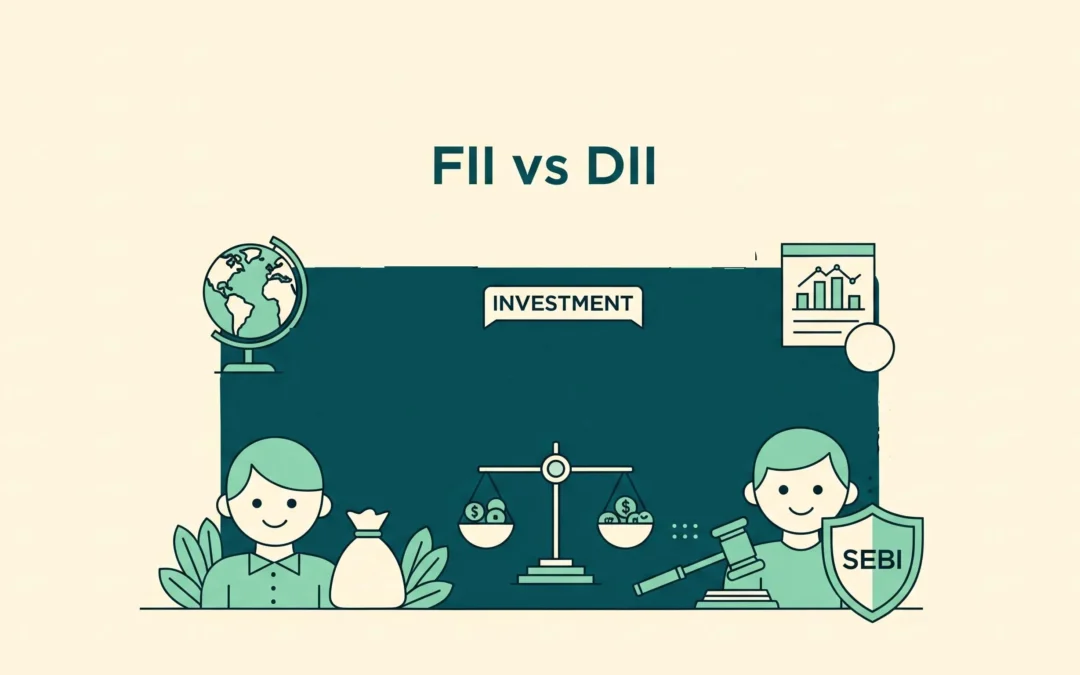Understanding Foreign Institutional Investors (FII) and Domestic Institutional Investors (DII) is important as they affect the Indian financial market to a great extent. They are essential for a smooth and stable capital flow. But people often confuse them not really understand the difference between them. They affect the market even with the slightest movement. Both FII and DII counter each other’s movement to stabilize the overall effect.
SEBI governs these bodies to establish trust among investors and protect them. This article with help you learn about FII and DII along with how they are regulated by SEBI.
Understanding Foreign Institutional Investors (FII)
Investment institutions that are based outside of India and make investments in Indian stocks, bonds, and derivatives are known as Foreign Institutional Investors (FIIs). These could include asset management firms, pension funds, hedge funds, and sovereign wealth funds.
Key Features:
- Foreign-based companies and other foreign entities are permitted to invest in Indian markets only after registering with SEBI as a Foreign Institutional Investor (FII) or Foreign Portfolio Investor (FPI), as per SEBI regulations
- Investment is made in derivatives, debt instruments, and stocks.
- Extremely sensitive to global economic indicators, such as shifts in US interest rates or geopolitical unrest.
- Currency markets are impacted by capital flows, which frequently result in the appreciation or depreciation of the Indian rupee.
- Causes short-term volatility by causing rapid inflows and outflows.
Let us now look at how FII impact the market movement:
- Market Volatility: Because of their rapid inflows and outflows, FIIs have the potential to cause quick market movements. Geopolitical risks, interest rate fluctuations, and global cues frequently influence their choices.
- Currency fluctuation: While strong inflows can strengthen the Indian Rupee and impact foreign exchange reserves and import prices, heavy FII outflows can cause it to depreciate.
- Index Sensitivity: FIIs frequently purchase large-cap stocks, particularly those in the Sensex and Nifty 50, which causes these indices to fluctuate in response to their movements.
- Sectoral Influence: FMCG, IT, and banking are among the industries that FIIs favour. The performance of these sectors may be disproportionately affected by their withdrawal.
Understanding Domestic Institutional Investors (DII)
The investment institutions that are based in India are known as Domestic Institutional Investors (DIIs). They raise local capital and use it to purchase Indian financial assets. These consist of banks, insurance providers like LIC, pension funds like EPFO, and Indian mutual funds.
Key Features
- DIIs use domestic savings to invest in the Indian financial markets, and they are funded by both Indian institutions and private investors.
- Less responsive to immediate news and more focused on long-term growth.
- It counterbalances the market’s stability by buying in during FII sell-offs.
- Follows Indian laws, such as those established by the IRDAI and SEBI.
- Engage in mergers, buybacks, and public offerings.
Let us now look how DII impact the market movement:
- Market Stability: DIIs ensure market stability, especially in downturns. Their long-term perspective aids in absorbing panic selling and offsets FII exit.
- Support in Times of Crisis: DIIs intervened with sizeable purchases during incidents such as the COVID-19 pandemic crash, assisting the market in recovering more quickly than anticipated.
- Investor Sentiment: Consistent DII purchases show faith in home fundamentals, which has a favourable impact on the actions of individual retail investors.
How SEBI Regulates Them?
SEBI is the governing body that regulates FIIs and DIIs in the following ways:
FII regulation
- The SEBI (Foreign Portfolio Investors) Regulations, 2019 require FIIs to register as Foreign Portfolio Investors (FPIs).
- FPIs are classified as either Category I (low risk, such as government and regulated funds) or Category II (moderate risk).
- A single FPI (Foreign Portfolio Investor) is generally restricted to holding up to 10% of a company’s stock, while the combined FPI limit is typically set at 24%—though this can be increased up to the sectoral cap with board or shareholder approval.
- Holdings, transactions, and beneficial ownership must be disclosed on a regular basis.
- SEBI collaborates with the RBI to keep an eye on foreign exchange inflows and outflows and control the currency.
- FIIs must pay capital gains tax, which is determined by the type and length of their investment.
DII regulation
- Mutual funds are governed by the SEBI (Mutual Funds) Regulations, 1996, which mandate risk management procedures, NAV publication, and comprehensive disclosures.
- Insurance companies are subject to IRDAI regulation, but SEBI also closely examines their market activity, such as initial public offerings (IPOs) and equity trades.
- Pension funds, such as EPFOs, are required to follow the asset allocation guidelines and investment caps established by SEBI in collaboration with PFRDA.
- Strict Know Your Customer (KYC) and Anti-Money Laundering (AML) regulations must be adhered to by all DIIs.
- SEBI monitors in real time and has the authority to penalize instances of insider trading, manipulation, or failure to disclose.
| Regulation Area | FIIs (Foreign Investors) | DIIs (Domestic Investors) |
| Registration with SEBI | Mandatory under SEBI (FPI) Regulations, 2019 | Mandatory under respective SEBI frameworks (e.g., MF, PMS, etc.) |
| Investment Limit in One Company | Up to 10% per FII Total FII cap: 24% | No explicit individual cap. Follow ownership norms per category |
| Taxation Oversight | Capital Gains Tax applicable STCG @15%, LTCG @10% (above ₹1L) | Same for equity mutual funds; DIIs themselves are tax-compliant entities |
| Reporting Frequency | Quarterly shareholding disclosures, voting activity, and ownership updates | Monthly/quarterly NAVs, asset mix, and AUM required |
| Monitoring by Regulators | Joint monitoring by SEBI + RBI (especially for forex flows) | SEBI only, or with IRDAI/PFRDA for insurance/pension firms |
Bottomline
The conclusion can be drawn that the Indian market is affected by both of them. FII influences the short-term movement of the market based on its buying or selling decision. If they decide to exit the market, it can cause a sudden fall in prices, causing a panic situation. However, DIIs neutralize the effect by buying in. This helps in maintaining the market situation.
SEBI has certain regulations for both of them to ensure that they are following the rules and operate in a controlled manner. It ensures transparency and security among the investors by ensuring predictability to a certain extent.


